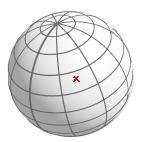3.2. Point #

A spherical point is an object without expanse but with a position. Use cases are:
sites on earth
star positions on the sky sphere
spherical positions on planets
A spherical point (or position) is given by two values:
longitude and latitude. Longitude is a floating point
value between 0 and
2. Latitude is a floating point
value, too, but between π- and
π/2π/2DEG) or
with a triple value of degrees, minutes and seconds
(DMS). Degrees and minutes are integer
values. The seconds are represented using a floating point
value. A fourth method is specifying a longitude value as
a triple value of hours, minutes and seconds
(HMS). But, you can not use it with
latitude values.
Example 3.1. A position specified using longitude and latitude in radians
sql> SELECT spoint '(0.1,-0.2)';
Example 3.2. A position specified using longitude and latitude in degrees
sql> SELECT spoint '( 10.1d, -90d)';
Example 3.3.
A position specified using longitude and latitude
(DMS)
sql> SELECT spoint '( 10d 12m 11.3s, -13d 14m)';
Example 3.4.
A position specified using longitude in
HMS, and latitude in
RAD
sql> SELECT spoint '( 23h 44m 10s, -1.4321 )';
As you can see you can combine the input format for longitude and latitude. The value pairs are always enclosed within braces. Spaces are optional.